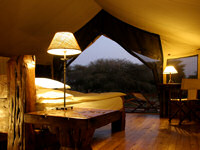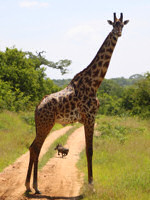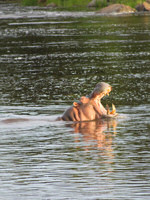Tanzania: A first timer's safari holiday
Safari virgin Nick McGrath is dazzled by the prehistoric panoramas of Tanzania’s magical Jongomero Camp.
The words, “off the beaten track” are often bandied around like a well-thumbed tourist guidebook, but in the case of Tanzania’s Jongomero Camp, they’re well chosen.
Unobtrusively located in the southern-most tip of Tanzania’s Ruaha National Park, 200km (124 miles) from the nearest town and two hours by stomach-churningly tiny plane from capital city Dar Es Salem – itself a two hour hop from Kenya’s East African hub Nairobi – this luxury eight tent camp is remoteness personified.
Peering over the banks of the parched Ruaha River and making up one third of the Selous Safari Company ‘s triumvirate of immaculately run camps, Jongomero combines jaw dropping wildlife, intimate hospitality and encyclopaedic bush knowledge to produce an environmentally sympathetic, captivating safari holiday.
I’m no camping aficionado but the Jongomero tents definitely aren’t your average fragile Glastonbury contraptions.
 A luxury tent in Tanzania's Jongomeru Camp
A luxury tent in Tanzania's Jongomeru CampSelous Safari Camp
Wedged beneath a cavernous stilted wooden structure, the centrepiece of these beautifully furnished canvas palaces is a bed big enough for a buffalo. The understated finishes –constructed by local carpenters using reclaimed Tanzanian materials – are exemplary but the real treat is the view.
Unzip your mosquito net and you’re greeted with a bush panorama and wildlife soundtrack that transports you straight into your own personal production of Jurassic Park.
The rival echo of elephants munching anything in their paths, vervet monkeys swinging between tangled vegetation and cackling hyenas scavenging for their next bush snack is an aural treat like no other.
And tempting though it was to savour the perpetually unfolding natural drama from the comfort of my balcony day bed, the real majesty emerges deeper into the bush.
Central to this experience at Jongomero is the camp’s very own Crocodile Tanzania, South African guide Andrew Molinaro (Moli), ably assisted by genial Californian camp hostess Noelle Herzog.
Even without his infectious zoological enthusiasm, the close proximity of Jongomero’s non-homo sapien inhabitants makes a jeep safari – or better still a walking safari – a life changing journey. But Moli’s ability to simultaneously educate and entertain escalates the experience to a whole new level, and by the time I’d sunk my final sun downer (a chilled Safari beer is highly recommended) as we parted, my brain was literally overflowing with fascinating bush insights.
Part of the thrill of any safari – whether you’re part of a heaving convoy of tourists in the more developed Masai Mara or the only humans for miles as we were in remote Jongomero – is the anticipation, and within minutes my expectations had been transcendentally exceeded.
First on the conveyor belt of peculiar creatures was a silver backed jackal, skulking behind a tangled baobab tree in the fading afternoon sun, closely followed by a family of comedy mongooses darting in the shadows.
Next up a dik-dik (“habitually paranoid and always monogamous,”) then a technicolor kingfisher, followed rapidly by a herd of daintily painted impala, a pair of snorting, mohican-ed warthogs, some furtive looking hudu antelopes and - ambling across the dirt road like a gang of ambivalent teenagers - a trio of magnificent elephants.
In an instant, decades of empty zoo encounters with these colossal characters became redundant as their gentle power and epic size filled my insufficiently powerful SLR’s viewfinder.
 A giraffe in Tanzania's Jongomeru Camp
A giraffe in Tanzania's Jongomeru CampSelous Safari Camp
But there was more. Minutes later I gawped at the unforgettable, dazzling appearance of zebras and a group of giraffes, gangling across the bush as the evening sun descended.
As dawn broke the next morning – following a memorable gourmet candlelit dinner on the dry bed of the Ruaha and a welcome 0530 hot chocolate wake up call - we entered the bush on foot in search not of the big five (elephant, rhino, buffalo, leopard and lion) but the little five (elephant shrew, rhino beetle, buffalo weaver, leopard tortoise and ant lion).
After the previous day’s exhilaration, the sense of potential anticlimax was tangible, but again, Moli’s talent as an entomological raconteur elevated the morning trek from mundane to magnificent; enlightening us as he did with myriad tales of termites’ intriguing social hierarchy, ant lions’ cunning predatory tactics and the reasons why giraffe poos look like Maltesers while hyena’s resemble 1970s British mongrels’ chalky pellets.
 A hippo in Tanzania's Jongomeru Camp
A hippo in Tanzania's Jongomeru CampSelous Safari Camp
But the highlight of the foot safari arrived shortly after we’d digested our hearty sunrise breakfasts within defecating distance of a group of chortling hippos, and creepy looking crocodiles wallowing in the morning sun.
Beyond the basking beasts, framed by the banks of the empty river and the stretching vista of rocks, shallow lagoons and decaying skeletons of generations of deceased species, lay a mesmerising, almost prehistoric scene of casually grazing giraffes, sunbathing baboons, swooping eagles and resting elephants, all virtually oblivious to our presence. It really was like a scene from The Land That Time Forgot but one that will be etched on my memory forever.
The only downside of my Jongomero journey is that it’s opened a safari itch that I suspect will need to be scratched time and time again.
FACT BOX
Tanzania Odyssey (tel: (020) 7471 8780; www.tanzaniaodyssey.com) offers a nine-night safari and beach experience in Tanzania from £3,930pp, including flights, transfers and full-board accommodation at Jongomero Camp, Selous Safari Camp and Ras Kutani. Game viewing drives and park entrance fees are also included.
Do you have any Feedback about this page?
© 2025 Columbus Travel Media Ltd. All rights reserved. No part of this site may be reproduced without our written permission, click here for information on Columbus Content Solutions.









 You know where
You know where